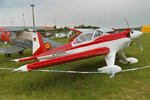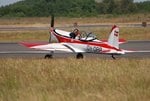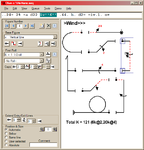Hi everyone,
OK, it's not a WW2 aircraft, but the forum seems to cover other topics so well that I thought I'd give it a try: Has anyone details on the Hirth Acrostar?
Specifically, I'd like to know:
What are the control throws for the
- elevator?
- ailerons?
- flaps?
- rudder?
What is the pitch range of the propeller?
What I have concluded from various popular books is that the ailerons and flaps both are moved by the elevator control, with the ailerons making only half of the travel of the flaps. From a photograph, it's also obvious that the flaps can extend above the "zero" position to give the wing inverted camber. Another conclusion from the books is that the flaps also serve as ailerons, and I'd think that the "half of the aileron travel" also applies here.
What I'm not sure of is if there is a way to extend the flaps other than by pulling back on the stick.
Details of the Eppler 467 airfoil used on the Hirth Acrostar would also be welcome - maximum lift coefficient or best lift-to-drag ratio for example would be helpful, but of course a polar plot would be appreciated as well! (If you have the coordinates, that would be almost as good.)
(If you have the coordinates, that would be almost as good.)
The concept of the Hirth Acrostar was to have an almost symmetrical aircraft that would fly upside down as good as right side up. The ailerons and flaps cambered the wing according to the elevator inputs so that the angle-of-attack of the main wing would change only very little in comparison to conventional aircraft.
I'm in the process of building an X-Plane model of the Hirth Acrostar (or rather converting one that was built for an older version - unfortunately without any knowledge of the special features of the Acrostar), and I've tried to make some educated guesses on the required values, but the resulting aircraft has some rather funny characteristics.
For example, as the main wing does not change the angle of attack much as lift is increased by increasing camber, my Acrostar model cannot effectively be stalled. This seems not right for an aerobatic aircraft.
Another effect is that due to the flat angle-of-attack coupled with the high idle speed of the Franklin engine used by the Acrostar, it's rather hard to slow down for landing, and elevator can not sensibly used to keep down the tail when using the wheel brakes as this causes the flaps to extend and the Acrostar to float up again.
The flying-tail style elevator has to be limited strictly in its travel as obviously, if the elevator stalls at low speed the pilot is going to lose control - if that happens during the landing, he'll lawn-dart immediately. (Don't ask how I noticed
Any information on the Hirth Acrostar would be most welcome! (I was surprised how little information there is on the internet, considering that it was a highly innovative and groundbreaking type!)
Regards,
Henning (HoHun)
OK, it's not a WW2 aircraft, but the forum seems to cover other topics so well that I thought I'd give it a try: Has anyone details on the Hirth Acrostar?
Specifically, I'd like to know:
What are the control throws for the
- elevator?
- ailerons?
- flaps?
- rudder?
What is the pitch range of the propeller?
What I have concluded from various popular books is that the ailerons and flaps both are moved by the elevator control, with the ailerons making only half of the travel of the flaps. From a photograph, it's also obvious that the flaps can extend above the "zero" position to give the wing inverted camber. Another conclusion from the books is that the flaps also serve as ailerons, and I'd think that the "half of the aileron travel" also applies here.
What I'm not sure of is if there is a way to extend the flaps other than by pulling back on the stick.
Details of the Eppler 467 airfoil used on the Hirth Acrostar would also be welcome - maximum lift coefficient or best lift-to-drag ratio for example would be helpful, but of course a polar plot would be appreciated as well!
The concept of the Hirth Acrostar was to have an almost symmetrical aircraft that would fly upside down as good as right side up. The ailerons and flaps cambered the wing according to the elevator inputs so that the angle-of-attack of the main wing would change only very little in comparison to conventional aircraft.
I'm in the process of building an X-Plane model of the Hirth Acrostar (or rather converting one that was built for an older version - unfortunately without any knowledge of the special features of the Acrostar), and I've tried to make some educated guesses on the required values, but the resulting aircraft has some rather funny characteristics.
For example, as the main wing does not change the angle of attack much as lift is increased by increasing camber, my Acrostar model cannot effectively be stalled. This seems not right for an aerobatic aircraft.
Another effect is that due to the flat angle-of-attack coupled with the high idle speed of the Franklin engine used by the Acrostar, it's rather hard to slow down for landing, and elevator can not sensibly used to keep down the tail when using the wheel brakes as this causes the flaps to extend and the Acrostar to float up again.
The flying-tail style elevator has to be limited strictly in its travel as obviously, if the elevator stalls at low speed the pilot is going to lose control - if that happens during the landing, he'll lawn-dart immediately. (Don't ask how I noticed
Any information on the Hirth Acrostar would be most welcome! (I was surprised how little information there is on the internet, considering that it was a highly innovative and groundbreaking type!)
Regards,
Henning (HoHun)





